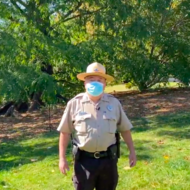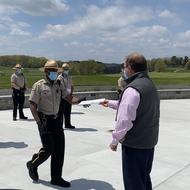Boston Park Rangers
The Boston Park Rangers serve the public in the tradition of "park keepers." The idea was conceived by Frederick Law Olmsted, the father of landscape architecture and the designer of Boston's Emerald Necklace park system.
The Boston Park Rangers serve the public in the tradition of "park keepers." Frederick Law Olmsted conceived the idea for park rangers. Olmsted was the father of landscape architecture and the designer of Boston's Emerald Necklace park system.
In 1982, the Boston Parks and Recreation Department Park Ranger Division was formed as a seasonal program. In 1988, the program became a year-round presence in the park system. The Park Rangers have three primary areas of responsibility:
- public assistance
- public safety and park protection, and
- interpretive programming.
We also encourage the proper use of Boston parks through education.
Rangers provide services in the nine Emerald Necklace parks. They also serve at Boston's historic burying grounds, neighborhood parks, and playgrounds. Ranger staff backgrounds include training in park management, recreation, liberal arts, law enforcement, and environmental studies. Rangers are trained in first aid, CPR, and crisis intervention. They are ready to respond to any emergency in the parks.
Meet the Boston Park Rangers!
Special duties
The mounted unit also serves as the Park Department's official Honor Guard. They attend:
- park openings
- tree lighting ceremonies, and
- many of the City's neighborhood parades.
The unit has had the distinct pleasure of participating in Presidential Inaugural Parades, as well as the CanAm Mounted Parade held in Toronto Canada.
Other duties expected of the unit include funeral details. They attend funerals by honoring dignitaries as well as fallen officials that have died in the line of duty.
Patrol and safety
As goodwill ambassadors, the Rangers meet and greet the public on a minute-by-minute basis. The Rangers are prepared to offer help to the hundreds of thousands of tourists and park patrons who visit each day. Rangers assist the general public in many ways. These include providing first aid, tourist information, directions, and information on park rules and regulations.
Interpretive ProgrammingThe Rangers are well known for providing information on the:
- historical
- cultural, and
- environmental features of the parks and their environs.
The Rangers encourage appreciation and proper usage of our urban green space. They do this by educating the public about the park system's environmental and historical value. Rangers also verbally enforce park rules and regulations.
To protect the park resources and the people who patronize the parks, the Rangers work closely with:
- fire and police
- conservation, and
- animal control service agencies in Boston.
We use the tools of verbal persuasion and education. Rangers enforce all City park rules and Bike Patrol regulations, as well as local, state, and federal laws and ordinances.
Rangers are called upon to provide a wide variety of services. These include (but are not limited to):
- enforcing Massachusetts Division of Fisheries and Wildlife regulations
- checking State fishing permits
- extinguishing all fires which do not require the immediate attention of the Boston Fire Department
- enforcing Pooper Scooper and leash laws
- assisting injured animals, and
- monitoring the park wildlife and its habit.
Mounted unit
In 1982, the Boston Park Ranger Mounted Unit was established through a coordinated effort with:
- the Boston Police Department, and
- the Boston Parks and Recreation Department.
In that year, the unit had a compliment of four mounts and four riders. The mounts were on loan (later donated) from the Boston Police Department. They were maintained in their stable at Franklin Park. During that year, mounted patrols were limited to the Arnold Arboretum. In 1987, the Boston Police Mounted Unit moved their main stables to the Brandigee Estate. The Boston Park Rangers established their own independent stable in Franklin Park.
Today, the Boston Park Ranger Mounted Unit is comprised of its own department horses, tack, trailers, and patrol vehicles. They now patrol all nine parks in the Emerald Necklace, as well as neighborhood parks and cemeteries. The rangers also perform special duties as necessary.
Over the years, the Boston Park Ranger Mounted Unit has grown into a highly recognized and respected agency in the City of Boston. The unit provides visitors and residents alike:
- public safety, and
- quality equestrian and educational programs.
Your responsibilities include:
- mucking and bedding stalls
- hand walking horses
- grooming, picking hooves, and cleaning tack
- stocking inventory, and
- sweeping and general stable maintenance.
To meet our minimum qualifications, you must:
- have previous hands-on horse experience
- have your own transportation
- be able to lift 50 pounds
- be able to commit to a minimum of four hours per week, and
- go through a background and CORI check.
Please send inquiries to Sgt. Hodari Keels at ranger.dispatch@boston.gov.
Training
To be eligible for mounted training, a Ranger must have served with the department for a minimum of one season. Prior horse experience is not required. Mounted training begins with learning basic horse psychology. Teaching new riders how and why horses think and react is fundamental in safely handling horses from the ground. Training also includes basic equine management, covering such topics as mucking, haltering, leading. Finer points of horse management that are also taught include:
- colic prevention
- horse anatomy
- emergency equine first-aid, and
- how recognize and treat common ailments.
The Rangers then learn basic horsemanship skills and are taught to ride. The Rangers ride a military seat with open toed irons and double reins. The trainees become proficient at the walk, trot, and canter. They are taught to back, side pass, turn on the fore, haunches, and jump. They are also trained in conducting programs with their mounts (Horse of Course, H.O.C.). This encourages positive interaction with the public.
The horses used by the Park Rangers are from various breeds and back grounds. They range in size from 15.1 to 17hh, are geldings, and usually of solid color. Ideally, the horses range in age from 4 to 9 years old. However, older sound, sane horses have been used.
After arrival to the stable, re-mounts are quarantined for 10 days. This allows the horse to rest and settle into a new environment. Over the next 20 days, the horse will be exposed to many things. Some things will be familiar, some completely foreign. The horse is ridden and evaluated on basic gaits and athletic abilities. After the 30-day evaluation, a decision is made to either keep the horse or reject him. A horse that is accepted is then assigned to a veteran rider and exposed to the rigors of life as a patrol horse.
Related Links
The official rules and regulations for public parks and other public places.
Special events in our parks require permits.
An organization made up of dedicated individuals, neighbors, & citizens who came together who assist and provide financial...
Interested in becoming a park ranger? Job postings will can be found here.







